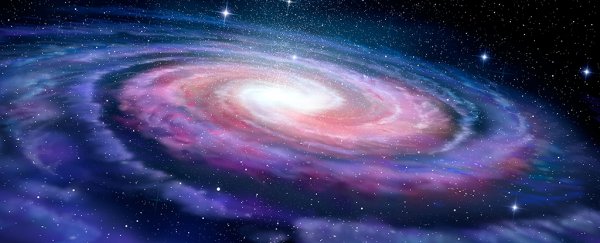There's a lot we still don't know about dark matter – we're not even 100 percent sure it exists – but for years, scientists have hypothesised that a huge disc of the mysterious stuff is slicing right through our very own Milky Way. Now, thanks to new calculations, that hypothesis is getting a whole lot more attention.
A new study suggests that scientists have overlooked one important clue in their calculations: that this hypothetical dark matter disc could make room for itself within our galaxy. If this disc can pinch in other types of matter – stars, gas, and dust – like the researchers suggest, then a dark matter disc begins to look more likely.
Physicist Lisa Randall of Harvard University first proposed her version of the dark disc theory in 2013. Dutch astronomer Jan Oort first floated the idea in 1932, after observing the irregular movement of the stars in our galaxy, and Randall has brought it out of obscurity. But, as Natalie Wolchover reports for Wired, it's a controversial idea that has more detractors than supporters.
Randall's new paper, written with Harvard graduate student Eric Kramer, is online at pre-press site, arXiv.org and has been accepted for publication in The Astrophysical Journal.
The pair explains that the total visible mass of the Milky Way is typically estimated by extrapolating outwards from the density of its midplane – the central line passing through the galaxy. If a dark disc exists and can pinch matter towards it – at the midplane – then our previous calculations are inaccurate.
That means the presence of a disc becomes possible, and perhaps even slightly probable, depending on the type of analysis used, they argue. The fact that no one was looking for a disc that could interfere with matter in this way is why a lot of previous studies haven't seen evidence for it, Kramer told Wolchover.
Other experts who've run the numbers say there's not enough room for error to leave the chance of a dark matter disc existing. "It's more strongly constrained than Lisa Randall pretends," astrophysicist Jo Bovy of the University of Toronto in Canada, told her.
Bovy, who wasn't involved in the new research, but has carried out his own measurements, thinks that even with a pinching effect in place, a disc could only account for 2 percent of the dark matter estimated to exist in the galaxy. That leaves a lot of unexplained dark matter.
Thanks to the Gaia space observatory, we might soon know one way or the other: it's currently carrying out a new inventory of the Milky Way, which will give us a more accurate account of the position and velocity of 1 billion stars.
What makes dark matter so head-scratchingly difficult to understand is that we can't actually see it – we can only guess at its existence by observing its effect on other elements in the Universe.
If a dark matter disc is indeed present, as Randall and Kramer suggest, then this shows dark matter would be able to shed energy, which in turn would mean it's even more complex than we previously imagined.
We can't wait to see what other researchers make of the latest hypothesis. One thing's for sure – in light of how much we still don't know about dark matter, nobody should be discounting any hypotheses out of hand just yet.
"I think it's very, very healthy for the field that you have people thinking about all kinds of different ideas," astrophysicist James Bullock from the University of California, Irvine, who was not involved with the study, told Wired. "Because it's quite true that we don't know what the heck that dark matter is, and you need to be open-minded about it."
